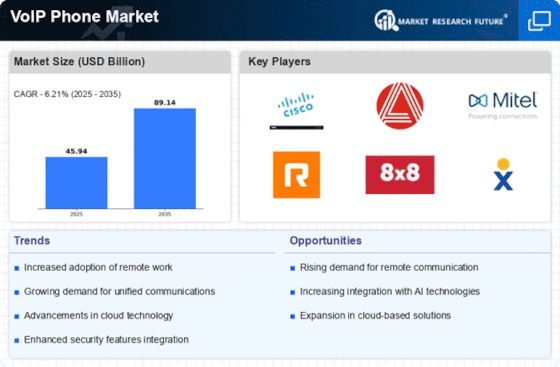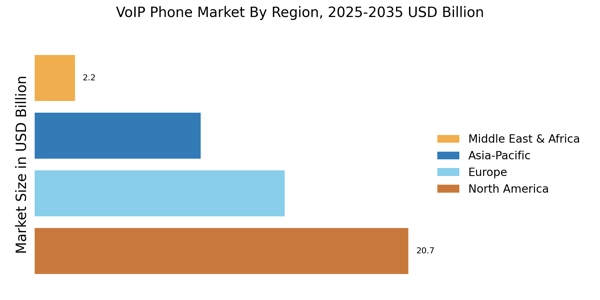Growing Remote Workforce
The VoIP Phone Market is being propelled by the growing trend of remote work. As organizations embrace flexible work arrangements, the need for reliable communication tools becomes paramount. VoIP technology facilitates seamless communication for remote teams, allowing employees to connect from various locations without compromising call quality. Recent surveys indicate that 70% of companies are now offering remote work options, which has led to an increased reliance on VoIP solutions. This shift in work culture is likely to sustain the growth of the VoIP Phone Market as businesses seek to equip their remote workforce with effective communication tools.
Focus on Enhanced Customer Experience
The VoIP Phone Market is increasingly focused on enhancing customer experience. Businesses are recognizing the importance of effective communication in building customer relationships. VoIP solutions offer features such as call routing, voicemail-to-email, and analytics that can significantly improve customer interactions. Data suggests that companies that prioritize customer experience see a 60% increase in customer retention rates. As organizations strive to differentiate themselves in competitive markets, the demand for VoIP services that enhance customer engagement is expected to grow, driving further expansion in the VoIP Phone Market.
Integration of Unified Communications
The integration of unified communications (UC) is a pivotal driver in the VoIP Phone Market. Businesses are increasingly adopting UC solutions that combine voice, video, and messaging into a single platform. This integration enhances collaboration and productivity, making it a compelling choice for organizations. Data shows that companies utilizing UC solutions experience a 20% increase in employee productivity. As more enterprises recognize the benefits of streamlined communication, the demand for VoIP services that support UC functionalities is expected to rise, further propelling the VoIP Phone Market.
Advancements in Internet Infrastructure
The VoIP Phone Market is significantly influenced by advancements in internet infrastructure. As broadband connectivity becomes more widespread and reliable, the feasibility of VoIP solutions increases. Enhanced internet speeds and reduced latency contribute to improved call quality, making VoIP an attractive option for businesses. Recent statistics indicate that regions with high-speed internet access have seen a 30% increase in VoIP adoption rates. This trend suggests that as internet infrastructure continues to evolve, the VoIP Phone Market will likely expand, accommodating a growing number of users seeking efficient communication methods.
Rising Demand for Cost-Effective Communication Solutions
The VoIP Phone Market is experiencing a notable surge in demand for cost-effective communication solutions. Businesses are increasingly seeking alternatives to traditional telephony due to the high costs associated with legacy systems. VoIP technology offers significant savings on long-distance and international calls, which can be particularly beneficial for small and medium-sized enterprises. According to recent data, organizations that have transitioned to VoIP have reported savings of up to 50% on their communication expenses. This trend is likely to continue as more companies recognize the financial advantages of adopting VoIP systems, thereby driving growth in the VoIP Phone Market.


















Leave a Comment